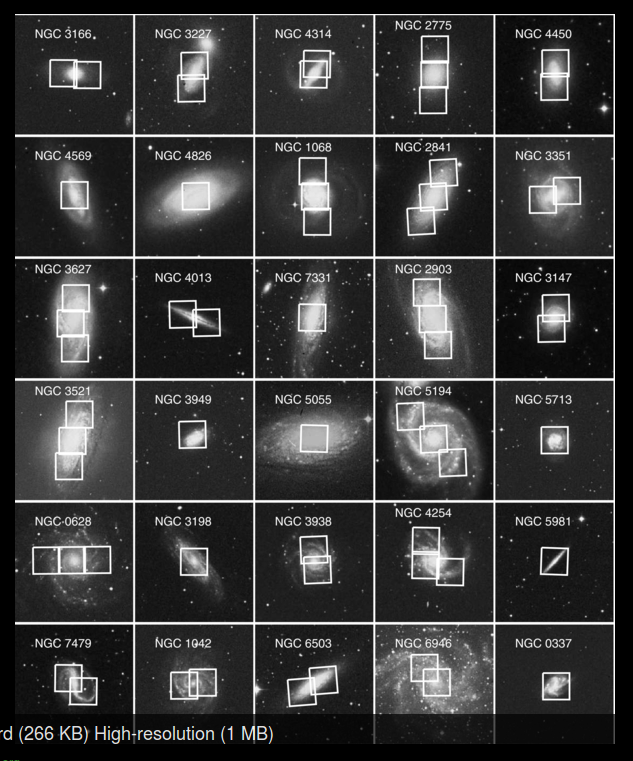Here I record some older header-based methods of locating PFC images
of specific galaxies.
- I am interested in one galaxy.
- The VENGA galaxies.
I am interested in one galaxy.
I usually want to track down available PFC images of a
particular galaxy. To make the initial lists of images, I use
the bash script "object_fits_list" and a directory path for
the top of my search. Below I show two examples: a search of
a small single run (August 2005), and then I survey my entire
collection.
% pwd
/home/sco/tmp
% ls
I can run this in any (empty directory).
% object_fits_list /home/sco/sco/Red_PhaseI_Data/aug_2005_p1
Searching at top level = /home/sco/sco/Red_PhaseI_Data/aug_2005_p1
See files: List.1 and List.2
% head -5 List.?
==> List.1 <==
/home/sco/sco/Red_PhaseI_Data/aug_2005_p1/Rsco5358.fits
/home/sco/sco/Red_PhaseI_Data/aug_2005_p1/Rsco5361.fits
/home/sco/sco/Red_PhaseI_Data/aug_2005_p1/Rsco5357.fits
/home/sco/sco/Red_PhaseI_Data/aug_2005_p1/Rsco5374.fits
/home/sco/sco/Red_PhaseI_Data/aug_2005_p1/Rsco5371.fits
==> List.2 <==
Rsco5358.fits N6946 V
Rsco5361.fits N6946 V
Rsco5357.fits N6946 R
Rsco5374.fits N6951 B
Rsco5371.fits N6951 R
Hence, the List.1 file gives the fullpath file names, and the List.2
gives the Fits file name, Object name, and filter name for each of
the images listed in List.1.
Now I search my entire image collection. I also use the
python script "object_unique_list.py" to find the unique
object names present in this collection.
% object_fits_list /home/sco/sco/Red_PhaseI_Data/
% wc -l List.*
2022 List.1
2022 List.2
% ls
List.1 List.2
% object_unique_list.py List.2 List.SCO_objects
I see a stream of names to standard out.
% ls
List.1 List.2 List.SCO_objects
% wc -l *
2022 List.1
2022 List.2
271 List.SCO_objects
The initial object_fits_list run took under a minute to run (on scohome). I
have a working list of 2002 images, and a set of 271 unique object names.
Next I want to concern myself with the galaxy NGC4618 (of course). First
I need to know how many unique OBJECT names I used for this target:
% cat List.SCO_objects |grep -n '4618'
240:NGC4618_U
245:NGC4618_R
251:NGC4618_B
258:N4618
% cat List.SCO_objects |grep -n '3664'
121:NGC3664_B
129:NGC3664_R
259:NGC3664_V
% cat List.SCO_objects |grep -n '6946'
226:N6946
247:NGC6946_R
254:NGC6946_B
% cat List.SCO_objects |grep -n '4725'
118:N4725_B
122:N4725_U
123:N4725_V
124:N4725_R
Hence, it is clear that I often included the filter name in designating
the name of a galaxy in a FITS header. Rather than code up some klugy
thing that handles all of these situations, I plan to just use multiple
runs, one for each name used, when I need to.
Collecting the images for a certain galaxy
The next thing I usually want to do is to build a list of all images (or
all images in a specific filter) for one galaxy. If I have used 4 different
'll do ths procedure 4 times! What I want is a script of code that
inspects, line by line, the entries in List.1 (full file names) and
List.2 (FITS name, OBJECT and filter). If my input OBJECT and filter name
match, I write the full file name out. Here's how I do it for NGC7479, where
I used the name string "N7479" in my OBJECT value in each FITS header:
% fits_select N7479 R
/home/sco/sco/Red_PhaseI_Data/oct_2004_p1/Rsco3217.fits
/home/sco/sco/Red_PhaseI_Data/oct_2004_p1/Rsco3225.fits
/home/sco/sco/Red_PhaseI_Data/oct_2004_p1/Rsco3223.fits
/home/sco/sco/Red_PhaseI_Data/oct_2004_p1/Rsco3218.fits
/home/sco/sco/Red_PhaseI_Data/oct_2004_p1/Rsco3224.fits
/home/sco/sco/Red_PhaseI_Data/oct_2004_p1/Rsco3228.fits
/home/sco/sco/Red_PhaseI_Data/oct_2004_p1/Rsco3227.fits
/home/sco/sco/Red_PhaseI_Data/oct_2004_p1/Rsco3226.fits
/home/sco/sco/Red_PhaseI_Data/oct_2004_p1/Rsco3212.fits
% fits_select N7479 R > list.R
% fits_select N7479 B > list.B
% fits_select N7479 V > list.V
% impuller list.R
The last command pulls over the FITS files for my R images. I can quickly
view these images using something like:
% ds9_open 1000 1000
% ls -1 *.fits > list
% ds9_multi_view list 800 6000
Another way I used in the past.
An alternative way of gathering PFC images
using the example of NGC3379 is described here .
The approach above is more general, but I'll document the older way here.
I show an example below that collects my NGC2403 images. Here I have to
know the name used as the OBJECT keyword in my FITS image (in this case N2403):
% fits_name_grab /home/sco/sco/Red_PhaseI_Data N2403 ./n2403
*** This took 2-3 minutes to run, then I have my N2403 images in a subdirectory named "n2403":
% gethead ./n2403/*.fits OBJECT INSFILTE
Rsco3507.fits N2403 R
Rsco3508.fits N2403 V
Rsco3509.fits N2403 B
Rsco3510.fits N2403 B
Rsco3511.fits N2403 R
Rsco3512.fits N2403 V
Rsco3513.fits N2403 V
Rsco3514.fits N2403 R
Rsco3515.fits N2403 B
Rsco3516.fits N2403 B
Rsco3517.fits N2403 V
Rsco3518.fits N2403 R
Rsco3519.fits N2403 R
Rsco3520.fits N2403 V
Rsco3521.fits N2403 B
Rsco3522.fits N2403 R
Rsco3523.fits N2403 V
I can break the images into useful lists by filter:
% run_imglis_all ./n2403 N2403
Images with object,filter = N2403 B
Start: Fri Apr 22 13:30:31 CDT 2016
End: Fri Apr 22 13:30:32 CDT 2016
N_image, filename: 5 LIST_IMS_N2403_B
Images with object,filter = N2403 V
Start: Fri Apr 22 13:30:32 CDT 2016
End: Fri Apr 22 13:30:34 CDT 2016
N_image, filename: 6 LIST_IMS_N2403_V
Images with object,filter = N2403 R
Start: Fri Apr 22 13:30:34 CDT 2016
End: Fri Apr 22 13:30:35 CDT 2016
N_image, filename: 6 LIST_IMS_N2403_R
% ls
AA* G1* keep0/ LIST_IMS_N2403_ALL LIST_IMS_N2403_B LIST_IMS_N2403_R LIST_IMS_N2403_V n2403/
% cat LIST_IMS_N2403_B
./n2403/Rsco3509.fits N2403 B
./n2403/Rsco3510.fits N2403 B
./n2403/Rsco3516.fits N2403 B
./n2403/Rsco3515.fits N2403 B
./n2403/Rsco3521.fits N2403 B
Return to top of page.
The VENGA galaxies.
Ordinarily this sort of small effort would not be worth documenting.
In this case I realized that in a few minutes I could use a few
bash and python scripts to do the job that, a year ago, I would have
done with fortran. The fortran effort would have taken a lot more
time and effort! So, I thought it useful to at least list the procedures
I used. The scripts reside in my permanent collections of
bash ($codes/bash) and python ($codes/python) codes.
